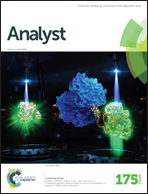Antibody purification via affinity membrane chromatography method utilizing nucleotide binding site targeting with a small molecule†
Abstract
Here, we present an affinity membrane chromatography technique for purification of monoclonal and polyclonal antibodies from cell culture media of hybridomas and ascites fluids. The m-NBST method utilizes the nucleotide-binding site (NBS) that is located on the Fab variable domain of immunoglobulins to enable capturing of antibody molecules on a membrane affinity column via a small molecule, tryptamine, which has a moderate binding affinity to the NBS. Regenerated cellulose membrane was selected as a matrix due to multiple advantages over traditionally used resin-based affinity systems. Rituximab was used for proof of concept experiments. Antibody purification was accomplished by first capture of injected samples while running equilibration buffer (50 mM sodium phosphate pH 7.0), followed by elution achieved by running a gradient of mild elution buffer (3 M NaCl in 50 mM phosphate pH 7.0). The results indicate that the m-NBST column efficiency for Rituximab was >98%, with a purity level of >98%. The quality and the capacity of this small molecule membrane affinity purification method is further evaluated for a number of parameters such as: injection concentrations, volumes, wash/bind time, elution gradient, antibody/protein-contaminant combinations, effects of injection buffer, post-purification antigen binding activity of antibodies, and column reusability and stability.


 Please wait while we load your content...
Please wait while we load your content...